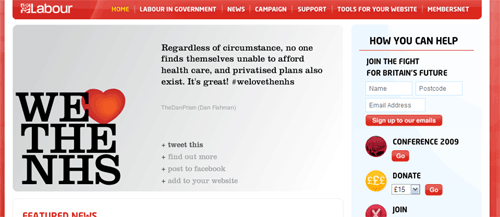
I’ve been a fan of Graham Linehan since he was a writer on Irish music (etc) magazine Hot Press. On Wednesday, he stuck a message up on Twitter reacting angrily against ‘rightwing wackjobs in the US lying about the NHS’. He starts using the hashtag #welovethenhs and asks celebrity chums to help spread the word. Soon it’s one of the hot hashtags on Twitter. And two days later, it still is.
All of which puts the Labour Party in a slightly tricky position. They tried – and largely failed – to stir up similar levels of pride in the NHS for its 60th anniversary. Things have unquestionably got better since they re-took power in 1997 (at a price, admittedly). Should they get involved in this spontaneous ‘grassroots’ explosion?
Initially, naturally, the involvement was as ordinary Twitter users; then yesterday, showing commendable responsiveness at least, a big splash on the Labour homepage, easy ‘tweet now!’ links to keep the momentum, plus a Facebook widget. But there have been a few expressions of concern that the Party shouldn’t be seen to hijack a grassroots thing like this.
Personally, I think they’re handling it pretty well. Opportunities like this don’t come along very often; as the cross-party support for the hashtag demonstrates, there aren’t many opportunities to get angry about the NHS in UK politics – and if any party can claim the NHS as ‘theirs’, it’s Labour. So they’re entirely within their rights to make something of it. For the most part, they’re keeping it within Twitter, where it belongs. And to be fair, in bringing it over to labour.org.uk, the treatment is relatively neutral – no Labour branding on the embeddable Flash widget, for example.
I’m already looking forward to hearing how the party leaders explain hashtags in their big conference speeches. 🙂

 PR Week is
PR Week is 